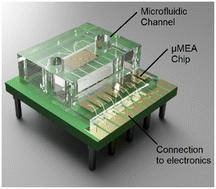Our official English website, www.x-mol.net, welcomes your
feedback! (Note: you will need to create a separate account there.)
Integrated microfluidic multiple electrode aggregometry for point-of-care platelet function analysis
Lab on a Chip ( IF 6.1 ) Pub Date : 2024-09-18 , DOI: 10.1039/d4lc00469h X Zhao 1, 2 , V R Gopal 2 , F Lozano-Juan 2 , K Kolandaivelu 3, 4 , A Sarkar 5 , D Wu 2 , J Su 2 , Q Cheng 1 , R Pang 1 , L-S Wu 1
Lab on a Chip ( IF 6.1 ) Pub Date : 2024-09-18 , DOI: 10.1039/d4lc00469h X Zhao 1, 2 , V R Gopal 2 , F Lozano-Juan 2 , K Kolandaivelu 3, 4 , A Sarkar 5 , D Wu 2 , J Su 2 , Q Cheng 1 , R Pang 1 , L-S Wu 1
Affiliation

|
Point-of-care (POC) platelet function analysis can enable timely and precise management of bleeding and clotting in emergency rooms, operation rooms and intensive care units. However, POC platelet testing is currently not commonly performed, due to the complexity of sample preparation and limitations of existing technologies. Here, we report the development of an integrated microfluidic multiple electrode aggregometry (μMEA) sensor which uses multi-frequency impedance measurement of an embedded microelectrode array to perform platelet aggregometry directly from whole blood, sensing and measuring platelet activation in a label-free manner and without requiring any additional sample preparation. Additionally, the sensor incorporates blood flow during the assay to account for physiological flow and shear conditions. We show that the impedance signal from the sensor can be used to accurately detect and quantify platelet aggregation in a label-free manner, which was further validated by simultaneous fluorometric measurement and visualization of platelet aggregation. Further, we optimized the sensitivity and repeatability of the sensor using its frequency response and demonstrated that the sensor could be used to characterize drug dose–response in antiplatelet therapy with a frequency-tunable dynamic range. We also demonstrate that the sensor provides high sensitivity to perform platelet aggregometry under thrombocytopenic or low platelet count conditions. The μMEA sensor could thus enable POC platelet function analysis across several clinical applications.
中文翻译:

用于床旁血小板功能分析的集成微流体多电极聚集测定法
床旁 (POC) 血小板功能分析可以及时准确地管理急诊室、手术室和重症监护室的出血和凝血。然而,由于样品制备的复杂性和现有技术的局限性,目前不常进行 POC 血小板检测。在这里,我们报道了一种集成微流体多电极聚集测定法 (μMEA) 传感器的开发,该传感器使用嵌入式微电极阵列的多频阻抗测量直接从全血中进行血小板聚集测定,以无标记方式传感和测量血小板活化,无需任何额外的样品制备。此外,传感器在检测过程中结合血流,以考虑生理流动和剪切条件。我们表明,来自传感器的阻抗信号可用于以无标记方式准确检测和量化血小板聚集,这通过同时荧光测量和血小板聚集的可视化得到了进一步验证。此外,我们利用传感器的频率响应优化了传感器的灵敏度和可重复性,并证明该传感器可用于表征具有频率可调动态范围的抗血小板治疗中的药物剂量反应。我们还证明,该传感器在血小板减少或血小板计数低的情况下进行血小板聚集测定时具有高灵敏度。因此,μMEA 传感器可以在多种临床应用中实现 POC 血小板功能分析。
更新日期:2024-09-18
中文翻译:

用于床旁血小板功能分析的集成微流体多电极聚集测定法
床旁 (POC) 血小板功能分析可以及时准确地管理急诊室、手术室和重症监护室的出血和凝血。然而,由于样品制备的复杂性和现有技术的局限性,目前不常进行 POC 血小板检测。在这里,我们报道了一种集成微流体多电极聚集测定法 (μMEA) 传感器的开发,该传感器使用嵌入式微电极阵列的多频阻抗测量直接从全血中进行血小板聚集测定,以无标记方式传感和测量血小板活化,无需任何额外的样品制备。此外,传感器在检测过程中结合血流,以考虑生理流动和剪切条件。我们表明,来自传感器的阻抗信号可用于以无标记方式准确检测和量化血小板聚集,这通过同时荧光测量和血小板聚集的可视化得到了进一步验证。此外,我们利用传感器的频率响应优化了传感器的灵敏度和可重复性,并证明该传感器可用于表征具有频率可调动态范围的抗血小板治疗中的药物剂量反应。我们还证明,该传感器在血小板减少或血小板计数低的情况下进行血小板聚集测定时具有高灵敏度。因此,μMEA 传感器可以在多种临床应用中实现 POC 血小板功能分析。


















































 京公网安备 11010802027423号
京公网安备 11010802027423号